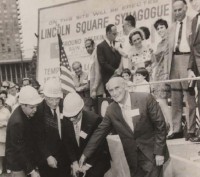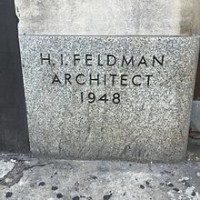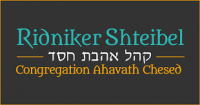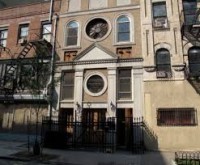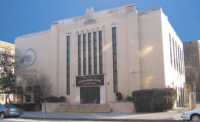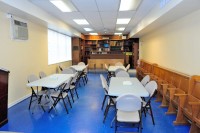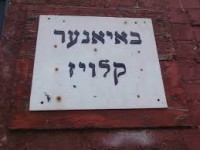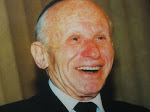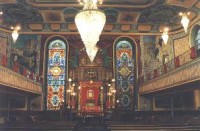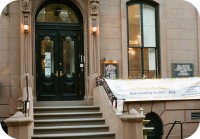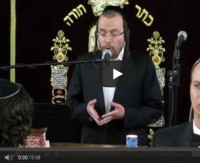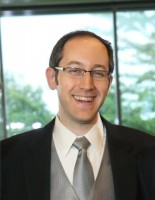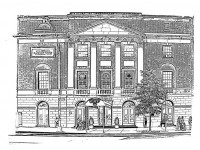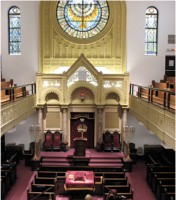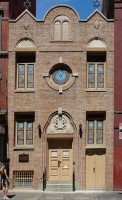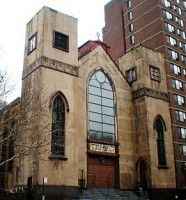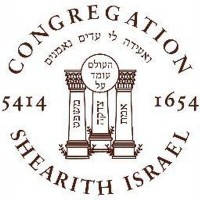LSS is a diverse and vibrant Modern Orthodox Congregation that provides religious, social, and educational services and outreach to the unique Jewish community of the Upper West Side. The synagogue strives to be a model in the integration of Halachic Judaism and contemporary life to the broader Jewish community.
In 1964, in the living room of an apartment in Lincoln Towers, a part-time rabbi from Yeshiva University named Steven Riskin took the budding Lincoln Square Conservative Synagogue by storm. His originality, charm and boundless energy captivated members and moved them to a more traditionally observant Judaism, in turn sparking a growing Jewish renaissance on Manhattan’s Upper West Side.
Before long, a new synagogue-in-theround made its debut at 200 Amsterdam Avenue, and the excitement at the renamed Lincoln Square Synagogue brought hundreds of young single professionals to the neighborhood, creating a vibrant scene for mixing and matching. Young families were also drawn to LSS, attracted by the dazzling teachings of Rabbi Riskin, assisted by Rabbi Herschel Cohen z”l and Rabbi Ephraim Buchwald, and the gorgeous melodies of Cantor Sherwood Goffin. “The New Orthodox” they called it on the cover of New York Magazine. Who knew? But as members struggled to navigate between the laws of Jewish tradition and the secular values of the surrounding society, Lincoln Square Synagogue began to see its destiny.
Just down the street from the temples of high culture at Lincoln Center, Lincoln Square Synagogue quickly established itself as a temple of an innovative kind, showcasing the classical and the contemporary, history and modernity. With joy and pride, the challenges of present-day living were brought into harmony with the ancient traditions passed down through the generations. The sacred liturgical texts of tefillah were infused with a new vitality as haunting, time-honored melodies shared the stage with the music of Shlomo Carlebach and The Rabbi’s Sons. The thirst for wisdom was quenched with the scholarship of Rashi and Rambam blended with the insights of 20th-century thinkers like Rabbi Abraham Isaac HaCohen Kook and Rabbi Joseph Dov HaLevi Soloveitchik. Everything old was new again.
What emerged was a synagogue with its own, unique, invigorating rhythm: home to meaningful and enthusiastic worship, to be sure, but also a place to establish lifelong friendships, build businesses and organizations, find soul mates and nourish the next generation through education and religious instruction. Thousands of Jews of all ages and backgrounds had come together to create a true makom kadosh, providing support for each other in times of sorrow and sharing joy in times of simcha. LSS was now a unified community whose commitment to Judaism and love of humankind extended beyond self and family to the world at large. You could walk in off the street for the first time, as so many did, and feel you’d been here before.
As the years flew by, the stunning success of Lincoln Square Synagogue brought with it newfound responsibility: to meet the needs of an increasingly diverse membership, an ever-expanding neighborhood and a 21st-century world. New solutions for new realities were required that would acknowledge the changing landscape, while staying true to the synagogue’s core principles and personality. Recognizing the difficulties faced by those forced to care for their children and their parents at the same time, and those older members in need of help, LSS became the first local Orthodox synagogue to add a part-time social worker to its core staff, guiding those needing support and companionship through the complicated maze of social service programs.
Identifying a resurgent thirst for Torah study on an individual, one-on-one level, LSS members founded the first full-time Modern Orthodox/Religious Zionist Kollel in the New York metropolitan area, offering the learned and the uninitiated new and exciting educational opportunities that reflected a love of Torah as well as eretz yisrael and am yisrael – the land and the nation of Israel.
And always mindful of the needs of the greater Jewish community, LSS members created the Lea Segre Tomchei Shabbos Fund providing free meals to those recovering from illness and childbirth or sitting shiva, as well as the Louis Lazar Benevolent Fund providing free religious articles like siddurim, mezuzot, and tefillin to those in need. All of this and weekly Bikur Cholim visits to Roosevelt Hospital every Shabbat afternoon, annual clothing drives, and a dedicated Chesed Fund that supports a variety of charitable causes in New York and across the country. As our sages teach, “olam chesed yibaneh” – acts of kindness build the world – and Lincoln Square Synagogue always does its part.
In 2013, LSS continued the next phase of its history and moved 100 yards south to 180 Amsterdam Avenue.
The synagogue was supported by the many millinery organizations that were based in the neighborhood. A group of these ready-to-wear industry business men had been meeting in various spaces, mostly in a loft on West 36th Street. Their rabbi during this very loosely organized time was Rabbi Moshe Ralbag. In January 1933, the congregation was more formally organized and the name of the synagogue, the Millinery Center Synagogue, was agreed upon, although the meeting place was temporary, at 1011 Sixth Avenue, on the second floor. Moe Brillstein (the father of film producer Bernie Brillstein) became president and started a building fund. At that point the congregation came together and decided to build a synagogue.
Due to the density of millinery businesses in the neighborhood, at its peak, services for daily minyan were typically so heavily attended that the prayer sessions were held in rotating shifts.
The synagogue was built by H.I. Feldman a prolific, Yale-educated architect who built thousands of Art Deco and Modernist-style buildings in New York City,notably 1025 Fifth Avenue (between 83rd and 84th Streets) on the Upper East Side and the LaGuardia Houses on the Lower East Side, as well as many buildings that line the Grand Concourse in the Bronx. Feldman and his company, The Feldman Company, also built the Federation of Jewish Philanthropies building (130 East 59th Street) and the United ewish Appeal building (220 West 58th Street).
There were wartime restrictions on building, so building was postponed for a time until 1947. The building's construction was completed in September 1948, and the synagogue was dedicated on September 12, 1948.
Shacharis (Mon-Fri) 7:15 am
Shacharis (Sunday) 8:15 am
Rosh Chodesh Shacharis 7:00 am
Daf Yomi (Mon-Fri) 6:30 am
Daf Yomi (Sunday) 7:30 am
Women’s Tehillim Group (every Wednesday) 9:00 pm
About Us
Congregation Ahavath Chesed is an Orthodox synagogue which was founded in 1944 and has remained in its original location on Manhattan’s Upper West Side since then. It was originally established by Rabbi Binyomin Halberstam זצ”ל, formerly Rabbi of Rudnik, Poland. From the outset, the intent was to recreate the ambiance and authenticity of the countless community shteibels that were essential to Jewish existence throughout Europe before World War II. Rabbi Halberstam sought to introduce this type of institution to post-war Manhattan as a refuge for worshippers who were then immigrating to America and for the benefit of the resident population.
Rabbi Halberstam was the driving force behind the Shul for the next two decades. He was succeeded in the mid-1960s by his son-in-law, Rabbi Shmuel Orenstein זצ״ל, who served as Rabbi with extraordinary distinction until his passing in 2006. Since Rabbi Orenstein’s passing, the Shul continues to draw inspiration and direction from the lessons that he taught during his lifetime. Recently, the membership of the Shul funded a very substantial endowment in memory of Rabbi Orenstein. The endowment will be utilized to finance Jewish scholarship that is consistent with his ideals.
During the past few years, there has been substantial growth in the membership and activities of the Shul. The daily Morning Prayer services have increased participation and the Shabbos morning service is particularly well attended. The Shabbos service is followed by a hot Kiddush providing time for the members to socialize and welcome new participants.
The Shul is presently embarking on a much needed renovation of its building on West 89th Street with the objective of enabling the facility to support the growing membership and the increasing number of Shul programs over the course of the next decade.
Congregation Talmud Torah Adereth El was established in 1857. It has the distinctionof being New York's oldest synagogue in its original location with continuous services. Founded four years before the Civil War, the history of Adereth El is intertwined with thatof New York City. Rabbi Sidney Kleiman OB"M served as the Rabbi of Congregation Talmud Torah Adereth El from 1939 – 1999. He continued attending services daily as Rabbi Emeritus until his passing at the age of 100 in the Spring of 2013. For more than a decade, Rabbi Gideon Shloush has infused the shul with his energy and creativity, and Adereth El is experiencing a wonderful renaissance. The Synagogue plays a vital role in New York's Jewish community. Adereth El serves the neighborhood through daily prayer services, weekly learning and outreach programs, an array of Shabbat activities, welcoming guests from around the world, providing assistance to those with loved ones in area hospitals
Adereth El's current membership reflects the diversity of its neighborhood, Murray Hill. During the work week, many Jewish businessmen with nearby offices pray at the synagogue. The congregation now includes a number of young, single members due to the growing popularity of Murray Hill with this population. Of note, many Adereth El members are students and faculty at the nearby New York University (NYU) medical center. The synagogue’s proximity to the hospital also brings in many hospital patients’ visitors as guests at Adereth El services. In fact, the synagogue typically has multiple weekly baby-naming ceremonies due to the large number of labor and delivery visitors. Additionally, due to Adereth El’s location near Yeshiva University’s Stern College for Women, many Stern students regularly attend the synagogue’s services.
The history of Congregation Adereth El is quite colorful and gives us an opportunity to look at the life and times of a Congregation as it struggles and grows in the most exciting city in the world. It is a reflection of the progress and accomplishments of New York Jews for 150 years. It is also an opportunity to look at and remember the names of men and women who have come and gone and yet whose mark lives on in the energies they gave to the Synagogue they loved.
The Text was written by Rabbi Sidney Kleiman and Andre S. Marx to be included in the 100th Anniversary Journal that was distributed at the Waldorf-Astoria Hotel on October 27, 1957. Not only did the authors undertake the massive job of reviewing the records and minutes of a century's worth of meetings, but it is obvious that they also did extensive field investigation in the community and at the records offices of New York City.
We’re doing something special for Purim this year, and the more of you participate, the more special it will be! Sign up for our first-everMishloach Manot Project to send your friends and fellow Stanton members traditional Purim food baskets. We prepare them for you, you sit back and enjoy Purim, proceeds go to the shul, and everybody wins!
How does it work? You should already have received an e-mail with instructions and your very own log-in code. Simply log-in to the Purim Project site and select the people you want to send to from the list of participants ($5/person or $180 for as many names as you want). The baskets will be available to be collected at the shul on Purim night,March 23, and Purim morning, March 24, when you come for megillah reading. (Please note, each participant receives one basket with a list of all the people who gave to them.)
We are honored to host the Honorable Martin Shulman this Shabbat, February 6, for a special talk in honor of Parashat Mishpatim (Laws). Judge Shulman’s talk on “Selected Torah and Secular Social Laws – No Need to Re-invent the Wheel,” will take place at 12:15pm, after kiddush, and will be followed by mincha. All are welcome!
Celebrate Shabbat with Stanton and the rest of America next week!
We will be having a community Shabbat dinner on Friday night,March 4, for the nationwide Sabbath observance known as Shabbat Across America. Click here to sign up now! The cost is $35/person or $30 for shul members. Sponsorships of $100 include dinner for two. Please let us know if you would like a vegetarian entree.
The Queens Jewish Center, also known as Queens Jewish Center and Talmud Torah or QJC, is a synagogue in Forest Hills, Queens, New York known for its significant contributions to the Jewish community. The synagogue was established by a dozen families in 1943 to serve the growing central Queens Jewish community.The current spiritual leader is Rabbi Simcha Hopkovitz.
The Queens Jewish Center building won honorable mention in the 1955 Queens Chamber of Commerce, Annual Building Awards. The architect was David Moed of Manhattan and the Builder was the LeFrak Organization.
The structure actually consists of two separate buildings. On October 3, 1946 an option was taken on the vacant plot where both Synagogue buildings now stand. Ground was first broken for the first building (also referred to as the Talmud Torah building or Bais Hamedrash building) during an elaborate ceremony on June 5, 1949, by Judge Paul Balsam and Center President Herman A. Levine. The ground-breaking for the Main Synagogue building took place on June 21, 1953 and was made possible by generous benefactor, Mr. Harry
Neighborhood
· Forest Hills was once the home of the US Open tennis tournament, played at the West Side Tennis Club before it moved to the USTA National Tennis Center in Flushing Meadows Park. When the Open was played at the tennis stadium, the tournament was commonly referred to merely as Forest Hills just as the British Open was referred to as Wimbledon.
· The neighborhood boasts a beautiful aura of old English infrastructure.
· The feeling of the neighborhood is a safe one. Conclusive for a healthy lifestyle , in mind body and spirit.
· It’s pretty picturesque scenery make it perfect surrounding for simply, better living.
· Only minutes away from the Mile long Austin street Shopping strip. As well as the large array of shopping opportunities of Queens Blvd and the boutique style antique shops of Metropolitan Ave. Truly a garden , to live in.
Welcome to the website of Young Israel of New Hyde Park. Located on the Queens/Nassau border we offer the best of suburban and city life, in a heimishe atmosphere. A vibrant membership of all generations contributes to the feeling of family for new arrivals and visitors alike. It's a shul where everybody knows your name. Being an Orthodox Shul in northeast Queens, YINHP plays a central role in increasing the presence and awareness of Orthodoxy in our community. Our Mikveh is our largest undertaking towards this goal and was completed in April 2013.
For more than half a century, the Young Israel of New Hyde Park has provided, and continues to provide, members and visitors with many of the things that an Orthodox family looks for and needs – daily minyanim, classes, and a newly renovated sanctuary that has received rave reviews from members and visitors alike. There is a community-wide eruv that has recently expanded into Lake Success.
We are most proud of our local school, Yeshiva Har Torah which is an outstanding modern orthodox day school with a new state-of-the-art facility, serving pre-K through 8th grade. Busing to all of the familiar yeshiva high schools is available as well.
The saying goes "location, location, location" and frankly you can't beat ours. The area features one fare bus and subway access and/or, express bus service to Manhattan, is a short hop to the LIRR and if you travel by car, is literally seconds away from the Northern State, Grand Central and Cross Island Parkways as well as the Long Island Expressway.
Shopping is a pleasure as within a couple of mile radius you have your pick of three major supermarkets, all of which feature a wide range of kosher products. For a more specialized kosher shopping experience we are moments away from Mazurs Glatt Kosher Butcher and Marketplace. Tired from all that shopping? Stop off for a bite at our local kosher pizza place, Green Olive, a delicious oasis right in the heart of our community.
Located around the corner from Long Island Jewish Medical Center, Zucker Hillside Hospital and Cohen Children's Medical Center as well as Parker Jewish Institute for Health Care and Rehabilitation (all of which are within our eruv ), the Young Israel of New Hyde Park has long been known as a place where the family and friends of patients can find the religious support they need and Shabbat and Yom Tov hospitality.
Davening Times
Weekday Times 2/7-2/13
Shacharit-Su 8:10 am
Shacharit-MTh 6:10 am
Shacharit-TuW 6:05 am
Shacharit-F 6:15 am
Latest Shema 8:55/9:31 am
Mincha/Maariv 5:05 pm
Shabbat Times Teruma
Friday Mincha 5:10 pm
Candle Lighting 5:07 pm
Shacharit 8:45 am
Mincha 5:00 pm
Shabbat Ends 6:11 pm
Historic Shaare Zedek Synagogue
For over a century, Congregation Shaare Zedek has served the Orthodox Jewish community
of northern Hudson County in New Jersey, including West New York, Guttenberg, North Bergen, Weehawken and Union City.
In 2012 we celebrated our Centennial. Some of our families have been with us since the beginning over a hundred years ago.
If you are part of our history, we invite you to contribute your story to our virtual book.
If you are new to Shaare Zedek we welcome you with open arms.
The synagogue is temporarily closed while we fix some building code violations and settle some fines.
When we reopen, we have services on Shabbat at 9:30 AM, and also on Jewish holidays.
We often have maariv on Friday – call us to check on the status: (201) 867-6859
Minyan Times:
Shacharis Sun: 8:15 AM
Shacharis Mon/Thu: 7:15 AM
Shacharis T/W/F: 7:15 AM
Shacharis Rosh Chodesh: 15 minutes earlier than normal
Mincha: 10 minutes before Shkia
Maariv: Follows Mincha Friday
Mincha: Between 10-15 minutes before shkiah
Shabbos Shacharis: 9:00 AM in winter 9:15 in summer Shabbos
Mincha: candle lighting time Motsei Shabbos
Maariv: aproximately 50 minutes after shkiah
Daf Yomi
Monday through Friday at 6:30 am
Edit Shiur
Daf Yomi
Shabbos
(45 min. before Mincha)
Boyaner Rebbe Shlit"a Speaking at Tish commemorating the Yohrtziet of his Alter Zeide The Pachad Yitzchock of Boyan Zatza"l at Mannhatan Day School on the Upper West Side, Feb 20th 2011. Hosted by the Boyaner Shtiebel of the West Side.
The Kehilla – A Brief Historical Review
K'hal Adath Jeshurun ("KAJ") was the name of the famed Kehilla in Frankfurt-am-Main, in pre-war Germany. It was established by Rav Samson Raphael Hirsch who was brought to Frankfurt in 1851 to lead the small remnant of the Orthodox community which had been decimated by the Reform. Disassociating ("Austritt" – Independent Orthodoxy) from the Reform and under the banner of his "Torah im Derech Eretz" approach, Rav Hirsch founded a school (the "Realschule") and rebuilt the Orthodox Frankfurt Kehilla to great success.
In the late 1930's, driven out of Europe by Hitler and his followers, a small number of German refugees who had settled in the Washington Heights section of New York joined together to establish a Minyan of their own where they could maintain their accustomed Minhagim and cherished tradition.
When Rav Dr. Joseph Breuer arrived in New York in February 1939, he was asked to become Rav of this Minyan which, at the time, was held only on Shabbos. Upon accepting this position, Rav Breuer immediately offered his home so that there could be regular weekday services. At the suggestion of the Rav, the minyan assumed the name of the famous Frankfurt Kehilla “K'hal Adath Jeshurun”. Like the Frankfurt Kehilla, this congregation was to become a full-fledged Kehilla to serve as a bastion of Independent Orthodoxy and a bearer of the "Torah im Derech Eretz" banner.
Rav Breuer was the grandson of Rav Samson Raphael Hirsch and the son of Rav Dr. Salomon Breuer, who had succeeded Rav Hirsch in his position as Rav of the Frankfurt Kehilla. Rav Dr. Joseph Breuer had served as the Rav of the "Klaus" synagogue in Frankfurt and as the Rosh HaYeshiva of the Frankfurt Yeshiva.
Rav Breuer saw the opportunity to rebuild the Frankfurt Kehilla of old, but at the same time making it a center that attracted not only people from Frankfurt and Germany at large but from many neighboring Kehillos of Europe. While in general the Kehilla continued the Minhagim of Frankfurt, some changes were introduced by Rav Breuer to accommodate members who came from other communities.
After the modest beginning, the Kehilla rented space in the Republican Club of Washington Heights. Soon the space proved too small and, in time for Pesach 1939, the hall of 90 Bennett Avenue was rented. During that year, a fire destroyed a large part of the hall and it became necessary once again to move to other quarters. The premises at 187th Street and Fort Washington Avenue were then rented until 1941, when the Kehilla purchased the building at 90 Bennett to serve as the Shul and, later, as the Yeshiva. The current Shul building at 85-93 Bennett Avenue was built in 1952 (and extensively renovated in 2001); the facility at 90 Bennett Avenue then began serving as a social hall. Originally called the Schuster Hall, it is now known at the Dr. Raphael Moller Auditorium.
In spite of great difficulties and enormous obstacles, Rav Breuer set out to establish the institutions required for an all-encompassing Kehilla. His initial effort called for the establishment and building of a Mikveh. Although he was advised by many that it was unrealistic to try to build a Mikveh at that time of war and economic uncertainty, Rav Breuer characteristically persevered and a building on 187th Street and Audubon Avenue was purchased and the Mikveh opened in 1943. The Mikveh was moved to its current location at 186 Street and Broadway in 1982 and extensively renovated in 2002.
Ever concerned with the welfare of the Kehilla, Rav Breuer asked Rav Shimon Schwab, then Rav of Congregation She’arith Israel in Baltimore, to join him in the Rabbinate in 1958. With his command of the English language, Rav Schwab was a special influence on the younger members. Under his guidance, the Yeshiva added a S’micha program. His erudition and oratorical ability gained for him and the Kehilla world-wide renown. For 22 years, Rav Breuer and Rav Schwab worked together to develop the Kehilla in all its aspects. Rav Breuer was niftar in 1980; Rav Schwab was niftar in 1995.
In 1987, the Kehilla asked Rav Zachariah Gelley to join the Rabbinate and assume the position of Morah D'Asrah and Av Bais Din. Rav Gelley had been the Rosh Yeshiva in Sunderland, England for 22 years. In 2006 the Kehilla invited Rav Yisroel Mantel of Lucerne, Switzerland, to join the Rabbinate.
"The Kehilla needs a Yeshiva" was a repeated appeal by Rav Breuer. In 1944 the Yeshiva, named Yeshiva Rabbi Samson Raphael Hirsch, was established and classes were held in the Shul building at 90 Bennett Avenue. Mr. Jacob Breuer was the elementary school Principal until he retired to Eretz Yisrael in 1986. Subsequent Principals were Rabbi Baruch Lichtenstein, Rabbi Reuven Drucker and Rabbi Nosson Adler; the present Principal, Rabbi Yehudah Moller, is a grandson of long-time president of the Kehilla, Dr. Raphael Moller. For decades Rabbi Emanuel Weldler served as secular studies principal of Junior High and High Schools. The Broadway Building was rebuilt as a school building in 1958 and the High School building next to the Shul was built in 1961. The Rika Breuer Teachers Seminary was established in 1963 under the leadership of Rabbi Joseph Elias. In 1973, the Mesivta and the Beth Medrash were relocated to a new building at 220 Bennett Avenue, named Beth Medrash al shem HoRav Shlomo Breuer.
The Beth Medrash was founded in 1958 by Rav Naftoli Friedler (the senior maggid shiur in the Yeshiva since 1948), who became the first Rosh Yeshiva. He was assisted by Rabbi Eliyohu Krieger who served the Yeshiva in various roles for over five decades. Rav Friedler was succeeded by, YB”L, Rav Yaakov Perlow, who in 1976 also assumed the position of the Novominsker Rebbe. During his tenure as Rosh Yeshiva the Kollel was started. In 1981, Rav Pinchos Kahn became Rosh Yeshiva; he was succeeded in 1986 by Rav Meir Levi, who is also the current rav of K’hal Adath Jeshurun of Monsey. Since 2009, Rav Yehoshua Rubanowitz has also held the title of Rosh Yeshiva. He has re-established a post-high school beis medrash program which has grown to over 70 bachurim.
Rav Breuer also oversaw the establishment of a Kashrus network, known for its integrity, as well as the gradual development of gemilus chessed institutions such as Chevros Kaddisho for men and women.
In 1947 Rav Breuer invited Rav Moshe Jacobovits to join him as Dayan of the Kehilla. Rav Jacobovits, a native of Lakenbach, Austria and a talmid of the Pressburg Yeshiva, assisted the Rav in the expanding Kashrus network and gave regular Shiurim. After his untimely passing in 1950, he was succeeded by Rav Eleazar Tarsis, a talmid of Rav Dr. Salomon Breuer and of Lithuanian yeshivos. In 1967, Rav Jacob Posen, a member of the Gateshead Kollel for many years, became the Dayan and in 1989 Rav Chaim Kohn became an additional Dayan of the Kehilla. Rav Eliyahu Glucksman joined the Kehilla in 1970 to serve the Rabbinate with particular involvement with the youth of the community and later became a Dayan of the Kehilla.
The burden of the administrative work of the Kehilla has been carried over the years by the Board of Trustees, headed first by Mr. Walter Joseph, followed by Dr. Raphael Moller, who served as president for 38 years. Rabbi Edwin Katzenstein succeeded Dr. Moller in 1980 and presided over the Kehilla at a crucial time after the petiros of Rav Breuer and Dr. Moller. Rabbi Katzenstein was succeeded in 1986 by Dr. Erich Erlbach, who served in that position until 2008. He was succeeded by Mr. Avram Cahn, who served for four years. Currently, Mr. Samson R. Bechhofer serves as president of the Kehilla.
Under Rav Breuer and his successors, the Rabbinate continues to adhere to the philosophy of "Independent Orthodoxy" which rejects both the legitimacy of other branches of Judaism and any dealings with organizations associated with them. KAJ also bases its approach and structure on Rav Hirsch's philosophy of "Torah im Derech Eretz", which encourages involvement in the modern world under the dominion of Torah without any compromise of loyalty to Torah and its precepts. Learning Torah is a core value of the Kehilla and there are many intensive shiurim and learning programs at various levels for men and women of all ages.
Unlike most Ashkenazic synagogues in the United States, which follow the Nusach Askhenaz ("Polish") liturgical rite, KAJ follows Minhag Ashkenaz ("German") in its liturgical text, practices, and melodies. Its first official Chazon was Mr. Abe Wertheim who was joined in 1949 by Mr. Robert R. Frankel (who officially “retired” in 1989 but continued davening at the Omud on many occasions through Shabbas Shuvah 2008 just days before he became ill and subsequently thereafter was niftar). In 1962, Mr. Frankel was joined by Rabbi David Kenner; after Chazen Frankel’s retirement, Rabbi Yisroel Meir Kenner served as Chazon together with his father for a period of 10 years. In 2001, Mr. Ezra Hes and Rabbi Ezra Lasdun were appointed Chazonim. Chazan Lasdun continues to serve as the Kehilla’s official chazon. The Chazonim, Baale Tefillo and the men and boys of the choir take great pride in perpetuating the familiar Niggunim of the Kehilla.
True to the concept of a full service kehilla, KAJ comprises a synagogue offering shiurim and lectures, a yeshiva, a beth medrash and a social hall. The Kehilla also provides its members with a Mikveh, the services of a Chevra Kadisha and a renowned Kashrus supervision.
About Us
The Old Broadway Synagogue is located at 15 Old Broadway, which is a small street that spans between 125th and 126th streets approximately half a block east of Broadway. Take the 1 train or M104 bus to 125th street and walk east to Old Broadway. We hold services every Friday at sunset, Shabbos mornings at 9:15 and Saturday afternoon 20 minutes before sunset. We have Sunday morning services followed by breakfast and a shiur with Daniel Fridman.
The Old Broadway Synagogue is the better known name of our congregation, the Chevra Talmud Torah Anshei Marovi. we were founded in 1911 in the West Harlem neighborhood of Manhattanville by a small group of Eastern European Jewish immigrants. The congregation originally met in storefronts and in the back of a bar until we built our own building in 1923 on Old Broadway. The congregation was active in the 1920s, 1930s and 1940s, but by 1950 was struggling when we hired Rabbi Jacob Kret. Together with his wife, Chana, Rabbi and Mrs. Kret brought the shul back to life by recruiting new congregants, at that point, mostly Holocaust survivors. May of these people moved on, but by this time, Rabbi Kret was a Talmud tutor at the Jewish Theological Seminary. He recruited students from JTS and later also from Columbia (he was a regular at Columbia's daily minyan and was the mashgiach in the Barnard kosher kitchen). For me Rabbi Kret embodied an ideal of Jewish authenticity: knowledgeable, observant, welcoming, warm and loving. We are doing our best to follow in his footsteps. In 2001, the shul was listed on the State and National Registers of Historic Places. We are slowly trying to restore the building and striving to be a beacon of Torah, Yiddishkeyt and Menschlikhkeyt in West Harlem.
Rabbi Moskowitz has focused much of his outreach efforts on the Jewish students at Columbia University. In recognition of his work there he was appointed as a "Religious Life Adviser" by the Office of the University Chaplain in partnership with Aish Hatorah New York. Rabbi Moskowitz has held several Aish co-sponsored events at Old Broadway and some of the students he has worked with through Aish have started to attend Old Broadway.
Following the tradition of Rabbi and Rebbetzin Kret, Rabbi and Rebbetzin Moskowitz regularly open their home and invite many Jews from the neighborhood to their Shabbos table every week. These efforts have resulted in more robust attendance every Shabbos and the understanding that Old Broadway is a happening place.
Another exciting development: the shul has been contacted by a group of Columbia staffers who work in the Manhattanville campus and who would like to have a regular Mincha minyan. The Columbia people, together with some of the Old Broadway regulars, have been meeting daily for Mincha since the beginning of December. This is the first daily minyan that has met at Old Broadway since the 1970s. The service takes place at 1:00pm Monday through Thursday at the shul and we invite you to join us. We look forward to seeing our new Mincha minyan grow.
Weekly Shiurim:
Rav Singer Chevra Mishnayos Shiur: Daily between Mincha & Maariv
Mishna Berura Yomis: Daily after Maariv
Daf Yomi by Rabbi Fishelis: Sun – Thu at 8:00 PM
Mishlei Shiur: Sunday mornings, 7:45 AM
Women's Shiur in Tehillim: Monday
Rabbi Romm's Ha'amek Davar Shiur for men and women: Wednesday at
9 PM
Torah Topics: given by Rabbi Mayer Friedman. Friday mornings, 9:15 – 10:15 AM
Shabbos Shiurim:
Rabbi Romm–1 hour before Mincha
Daf Yomi–1 hour before Mincha
The Bialystoker Synagogue was organized in 1865 on the Lower East Side of New York City. The Synagogue began on Hester Street, moved to Orchard Street, and then ultimately to its current location on Willet Street, more recently renamed Bialystoker Place.
Our congregation is housed in a fieldstone building built in 1826 in the late Federal style. The building is made of Manhattan schist from a quarry on nearby Pitt Street. The exterior is marked by three windows over three doors framed with round arches, a low flight of brownstone steps, a low pitched pedimented roof with a lunette window and a wooden cornice. It was first designed as the Willett Street Methodist Episcopal Church.
In the corner of the women’s gallery there is a small break in the wall that leads to a ladder going up to an attic, lit by two windows. Legend has it that the synagogue was a stop on the Underground Railroad and that runaway slaves found sanctuary in this attic.
In 1905, our congregation, at that time composed chiefly of Polish immigrants from the province of Bialystok, purchased the building to serve as our synagogue. During the Great Depression, a decision was made to beautify the main sanctuary, to provide a sense of hope and inspiration to the community. The synagogue was listed as a New York City landmark on April 19, 1966. It is one of only four early-19th century fieldstone religious buildings surviving from the late Federal period in Lower Manhattan. Richard McBee and Dodi-Lee Hecht have both written in-depth articles about the building.
In 1988 the Synagogue restored the interior to its original facade, and the former Hebrew school building was renovated and reopened as The Daniel Potkorony Building. It is currently used for many educational activities. Our most recent project was the refurbishing of our windows.
The Synagogue has continued to be a vibrant and reputable force in the religious world. In recent years a substantial number of new families have chosen to make it their place for prayer and study.
Welcome to Congregation B’nai Avraham, the Orthodox synagogue in Brooklyn Heights. As the only Orthodox synagogue in the neighborhood, we serve a unique role in accommodating people with divergent religious backgrounds and at varying levels of observance. We welcome all!
Our goal is to increase the level of Jewish awareness, knowledge and observance by providing a warm, welcoming community with activities to appeal to people at all levels and with varying interests. We provide a daily morning and evening minyan and more than ten classes a week for adult learning, as well as beginner’s services and children’s services on Shabbat. Our Mei Menacham Mikvah is perhaps the most beautiful mikvah in the City.
Our membership includes both Ashkenazim and Sephardim, and our members’ first languages include Hebrew, Russian, Yiddush, French, Spanish and Arabic, as well as English. Our spiritual leader, Rabbi Aaron L. Raskin, is a member of the Chabad movement, and during services most people use the RCA ArtScroll Siddur and the Stone Chumash, although other Siddurim and Chumashim are readily available.
Come to Saturday services and enjoy a sociable kiddush afterwards, or stop by at one of our many classes, or come to a Friday night dinner with singing, joy and a guest speaker. Whether you are a yeshivah graduate, baal teshuvah, considering conversion or totally new to matters Jewish, we welcome you, and you will find a comfortable place in our vibrant community.
Daily Classes
There’s always something happening at B’nai Avraham! Every day of the week Jewish education classes are taught for free in English.
If you want to pursue your Jewish education, there are no more excuses. See our *list of classes* for more particulars. Don’t see your topic on the list? Ask us!
History
In the Summer of 1988 Stephen and Penny Rosen, having recently become more observant, wanted to establish an orthodox Shabbat minyan. Together, they contacted Rabbi Shimon Hecht of B’nai Jacob in Park Slope, who supplied them with a Torah scroll, books, and a very young man to lead services and read from the Torah. Space was rented from a local theater group, signs posted, calls made, and the hope was that someone would show up for the scheduled Rosh Hashanah and Yom Kippur services. Initially, there were the Rosens, Drs. Walter and Brenda Molofsky, previous members with the Rosens of a local Conservative Synagogue, the young man (Rabbi Aaron L. Raskin) and Rabbi Raskin’s brother Shua, who was recruited to walk from Crown Heights with the Rabbi.
Amazingly enough, other people came so that there was a minyan, and the first and only Orthodox Synagogue in Brooklyn Heights began.
After Yom Kippur, holiday and Saturday morning services were held at the Rosen’s residence for the next nine months. The Congregation was officially founded as a religious corporation in December 1988. It was named B’nai Avraham in honor of Stephen Rosen’s grandfathers, both of whom had the Hebrew name “Avraham.” Rabbi Raskin noted that “B’nai Avraham,” literally, “children of Abraham” is the name given to converts, and the Congregation has had many converts among its members. After nine months at the Rosens’, the Congregation rented a parlor floor apartment on Clinton Street. As the landlady lived upstairs, the front door had to remain locked. Generally, Stephen Rosen waited at the front door to let people in. Latecomers tossed pebbles against a window and someone would come down to let them in.
We then moved to a commercial space at 100 Clinton Street, where at long last, we could leave the door open. Finally, in 1996, we moved to our current location at 117 Remsen Street, purchased from the Brooklyn Heights Synagogue (Reform), which acquired a larger building three doors away.
In 2000, the Mei Menachem Community Mikvah was built. It is one of the most beautiful and elegant Mikvahs in the New York area.
Rabbi Ben Skydell has been the rabbi at Congregation Orach Chaim since January 2013. He follows an illustrious tradition of major American Rabbis to have served as the Congregation’s Rabbi, including Rabbis Michael D. Shmidman, Kenneth Hain and Simon Langer.
A native of Manhattan’s Upper West Side, Rabbi Skydell is a graduate of Yeshiva College and the Rabbi Isaac Elchanan Theological Seminary. He is a long-time faculty member of the North Shore Hebrew Academy High School, and the Drisha Institute for Jewish Education, and taught for several years at Yeshivat Hadar. Rabbi Skydell also served on the rabbinic staff of Congregation Beth Sholom of Lawrence, New York for nine years.
Rabbi Skydell’s areas of interest include the intersection of Halacha and history, the spiritual worlds of mussar and hasidut, and the historical world of the Rabbis of the Talmud. Rabbi Skydell’s dynamic and engaging presentation has made him a sought-out speaker on college campuses throughout the United States.
Rabbi Skydell is married to Shani, a dedicated social worker and teacher. They are the proud parents of Hannah, Emmie and Zacky.
Cantor Yaakov Y. Stark has been described as possessing “a voice of great beauty, clear and true…breathtaking, radiant, as though from another world.” A child prodigy, at the mere age of seven Yaakov Yoseph Stark was already thrilling congregations with his heartrending solos on the High Holidays. His talent and ability were nurtured by the distinguished cantors in his family, and through continuously listening to the master cantors of the golden age: Rosenblatt, Hershman, Kwartin, Pinchik, Glantz and Koussevitzky. Huge crowds of people regularly attend to savor the stirring songs and timeless tefillos eloquently enhanced and warmly delivered by their beloved cantor. Cantor Stark was privileged to perform at numerous sold-out concerts with the most prestigious philharmonic orchestras and finest choirs throughout the world. His lyric tenor voice has put him in constant demand as a guest cantor in synagogues worldwide. Cantor Stark resides in Williamsburg, Brooklyn, with his wife and children.
Rabbi Shmidman has served the Orach Chaim congregation and Upper East Side community since 1988. In addition to Rabbinic ordination, he holds a Ph.D. degree in Public Law and Government from Columbia University. He has served as Professor and Chairman of Political and Social Science at City University of New York and most recently as Dean of Undergraduate Jewish Studies at Yeshiva University. A widely recognized scholar, he is acclaimed as an outstanding teacher and inspiring preacher. An ardent Zionist, he has been honored by religious, social and cultural institutions in Israel and the United States.
Rabbi Yosie Levine joined The Jewish Center's rabbinic team in 2004. He earned a BA in English and Comparative Literature from Columbia College and was awarded the university's William F. Curtis award for outstanding oratory. A Wexner Graduate Fellow, Rabbi Levine received rabbinic ordination from the Rabbi Isaac Elchanan Theological Seminary and was the winner of RIETS' writing prize. He holds an MPA in Public Policy from NYU's Robert F. Wagner Graduate School and is currently pursuing a doctoral degree in Modern Jewish History at Yeshiva University's Bernard Revel Graduate School. Rabbi Levine served as Rabbinic Intern, Assistant Rabbi and Associate Rabbi at The Jewish Center where he received practical rabbinic training and mentoring from Rabbi Ari Berman. Before joining the Center, he served as the educational director of the Lauder Foundation's Beit Midrash in Berlin, Germany and as the visiting scholar of Congregation Knesseth Israel in Birmingham, Alabama. Rabbi Levine has taken a leadership role on the issue of day school affordability and serves as the chair of Manhattan Day School's Political Advocacy Committee. He is co-chair of the Manhattan Eruv and is active in numerous communal organizations including AIPAC and the Beth Din of America and serves on the Board of UJA-Federation of New York. Rabbi Levine's wife, Rachel, is a clinical psychologist in private practice in Manhattan. They are the proud parents of Akiva, Yehoshua, Ari and Judy.
Rabbi Dovid Zirkind, a native of Baltimore, Maryland, joined The Jewish Center clergy in July 2012. After two years of study at Yeshivat Kerem B’Yavneh in Israel, Dovid continued his education at Yeshiva University. There he received his undergraduate degree in Psychology, graduating from the Yeshiva Program with honors. Upon graduation, Rabbi Zirkind attended the Rabbi Isaac Elchanan Theological Seminary, studying in the Marcos and Adina Katz Kollel. In 2010, Rabbi Zirkind joined the Yeshiva University Torah MiTzion Beit Midrash of Toronto, where he studied full time in the Beit Midrash and served as Rabbinic Assistant at Shaarei Shomayim Congregation. In that role, Rabbi Zirkind taught classes throughout the Greater Toronto Area, crafted programs and curricula for adults, college students and children alike and trained under a number of the communities leading Rabbis.
In his role as Assistant Rabbi of The Jewish Center, Rabbi Zirkind services the full gamut of our membership. He is the director of our Adult Education program, Jewish Center University, leads our daily minyanim and heads our Young Leadership Minyan and programming. Internally, Rabbi Zirkind teaches a number of ongoing classes and shiurim, including Talmud, Contemporary Ethics and Jewish Law. He believes that passionate Torah Study should be text based, highly engaging and grapple with the major issues of our time. In the broader community, Rabbi Zirkind increasingly represents our shul as well. He is teacher at Manhattan Day School and a frequent lecturer in local institutions including; the JCC, West Side Sefardic Synagogue, Congregation Rodeph Shalom, the RIETS Rabbinic Training Seminar and others. In addition, as a UJA Federation Grant Recipient, Rabbi Zirkind currently leads the inaugural cohort of The Jewish Center Social Action Fellowship (JCSAF). Together with his wife, Ariella, the Zirkind’s lead sought after personalized marriage workshops, which include Chattan & Kallah classes and ongoing Taharat HaMishpacha and fertility counseling for young families.
Ramath Orah has a unique legacy among Upper West Side synagogues. Founded in 1941 by Rabbi Dr. Robert Serebrenik, the synagogue’s original congregation was comprised of 61 refugees from Luxembourg who escaped the Nazi occupation under extraordinary circumstances. When they arrived in New York they immediately began the work of establishing a congregation in their new home. By 1942, they had founded Congregation Ramath Orah, naming it after the community they'd left.
We want our children to love the experience of shul so that they look forward to coming every Shabbat and holiday. We want our congregants to enjoy each others’ company, linger over Kiddush, laugh with one another, and be comfortable in our shul. For our members, we want to be the first place that they think of when it is time to celebrate a simchah, and the community they turn to in times of loss.
Worship – We are a place where Jews may worship together in an atmosphere that maximizes our ability to forge a relationship with G-d. Our community embraces spiritual, melodic prayer, from a Carlebach-style Kabbalat Shabbat, to festive holiday celebrations, and daily prayer.
Learning – We are deeply committed to study and education, and there are opportunities every week to learn with our rabbis and visiting scholars.
Chesed – We are dedicated to the ideals of bikur cholim (visiting the sick) and g’milut chasadim (doing good deeds), and the Ramath Orah Team of Chesed (ROTC) can often be seen visiting sick or elderly members of the community. We seek to integrate Chesed programs into the life of our community and to involve as many of our congregants as we possibly can in our Chesed programs.
Zionism – As a Jewish community, we are strongly committed to the State of Israel and encourage advocacy and activism. We believe that the creation of the State of Israel marks the beginning of the fulfillment of G-d’s promise to the Jewish people and foreshadows our ultimate redemption. Accordingly, the preservation of the Jewish State and the ability of its citizens to live in peace, safety and prosperity is a goal of our congregation, one which we not only pray for, but contribute our time and resources to help achieve.
Engagement – All members of our community are active participants, . While everyone is welcome to attend davening in our main sanctuary on holidays, we also host a monthly women’s prayer group and weekly Children’s Shabbat programs.
We are not judgmental of our fellow Jews, and we welcome all to our synagogue and accord honors in our services without regard to affiliation or non-affiliation of our members and guests. Ramath Orah seeks to be at the forefront of mutual tolerance and respect for Klal Yisrael. Ramath Orah, moreover, does not turn away anyone, either from participation in shul activities or from receiving honors, because of an inability to pay dues or make contributions.
We aspire to be a synagogue that makes every visitor, from the moment he or she enters our Shul, feel welcome and appreciated. We want every congregant to feel a personal obligation to reach out not only to visitors and new members, but to their fellow congregants. Click here to learn more about our hospitality program.
Congregation Ohab Zedek, or OZ, as it is fondly known, is more than just a synagogue. Under the leadership of Rabbi Allen Schwartz, the Shul is known for its open doors and big heart. OZ has broad ties with the surrounding Jewish community and its Upper West Side neighborhood as a whole. A random visitor could easily encounter an up and coming scholar from Israel, or members of the local fire station. It is an informal, comfortable, inclusive community.
OZ is a modern Orthodox congregation, but any individual is welcome, regardless of background or means. It is a Shul of interlocking communities–young families who find a relaxed setting on Shabbos morning to introduce their toddlers to services; singles, who famously crowd the steps on Friday night; and seniors, many of whom have been members of OZ for decades. It is home to those tentatively exploring Judaism as well as the most learned, who are stimulated by a broad array of lecturers and classes.
Rabbi Allen Schwartz became the spiritual leader of Congregation Ohab Zedek in 1988. He is an alumnus of Yeshiva College and received his Master of Arts Degree in Bible, Rabbinics and Halacha from Yeshiva University's Bernard Revel Graduate School, where he continues to work on his doctoral thesis on Rashi's methodology. Rabbi Schwartz was granted Smicha from the University's affiliated Rabbi Isaac Elchanan Theological Seminary. He currently holds the Raymond J. Greenwald Chair in Jewish Studies at Yeshiva University, where he has taught since 1983.
Rabbi Schwartz and his wife Alisa moved to the Upper West Side in 1985, where he served as rabbi at Congregation Ohav Shalom before moving to the pulpit at Ohab Zedek. Rabbi Schwartz's major focus at OZ is to foster connections within and among the many different age groups and constituencies of Jews living on the Upper West Side. Seeking to make all kinds of religious opportunities available to Ohab Zedek members, he brings information to the community regarding such subjects as Chesed, Tzedakah, Torah learning, Shatnes testing, Tefillin and Mezuzah service, and assistance with Mitzvah and Shabbos observance. Rabbi Schwartz's goal for the community is to make every OZ attendee a member of the larger community family.
Rabbi Schwartz gives weekly classes on a variety of subjects at OZ and also taught fifth through eighth grades at Manhattan Day School. He has lectured extensively for the Board of Jewish Education of New York at elementary and high schools in the New York area. Rabbi Schwartz has published curricula on Biblical themes for Jewish day schools nationally and has written Bible curricula for Yeshiva day schools and high schools. He serves on the executive board of the Rabbinical Council of America and has also served as President of the Council of Orthodox Jewish Organizations of Manhattan's West Side. Rabbi Schwartz was the camp rabbi and educational director of Camp Morasha from 1996 to 2000 and then served as the educational director of Camp Mesora from 2002 to 2005 and continues to dedicate time during the summer months to serve its educational staff.
Rabbi Schwartz recently completed a scholarly edition of the Commentary of the Rokeach to the Book of Proverbs.
Rabbi and Alisa Schwartz have six children and eleven grandchildren.
קהילה קדושה יאנינה הוא בית כנסת הנמצא ברחוב ברום (Broome) 280 בין רחובות אלן (Allen) ואלדרידג' (Eldridge) בלואר איסט סייד במנהטן ניו יורק. הוא נבנה בשנים 1925-1927 ותוכנן על ידי סידני דאוב. הוא בית הכנסת היחיד בחצי הכדור המערבי שנוהגים בו בנוסח הרומניוטים השונה גם מנוסח אשכנז וגם מנוסח ספרד.
לקהילה קדושה יאנינה יש ייחוד בהיותו בית הכנסת הרומניוטי היחיד בחצי הכדור המערבי הקהילה נוסדה ב-1906 על ידי מהגרים יהודי יוונים מיואנינה, אבל בית הכנסת לא הוקם עד 1927. השנים מאז ועד מלחמת העולם השנייה היו שנים של שפע לקהילה הרומניוטית בלואר איסט סייד. כיהנו בבית הכנסת שלושה רבנים ובימים הנוראים היה בית הכנסת מלא מפה לפה. אחרי מלחמת העולם השנייה עבר חלק גדול מבני הקהילה לרבעים אחרים וחלקים אחרים של מנהטן כולל הרלם, ברונקס וברוקלין. קהילות אלה כבר אינן פעילות היום. למרות שהקהילה התמעטה באופן קבוע מאז ימי הזוהר שלה לפני המלחמה הרי עדיין מתקיימות תפילות בבית הכנסת בשבתות ובחגים. למרות שיש לבית הכנסת רשימת תפוצה של 3,000 אנשים הרי, לעתים קרובות, חסרים אנשים למניין בתפילות השבת. סיורים מודרכים מתקיימים בכל יום ראשון למבקרים. לקהילת יאנינה יש חלקה בבית העלמין בוולווד (Wellwood). שם יש גם מצבת זיכרון ליהודי יאנינה שנספו בשואה.
הבניין נוסף לרשימה הלאומית של מקומות היסטוריים ב-30 בנובמבר 1999 וצוין כנקודת ציון של העיר ניו יורק ב-11 במאי 2004 . הוא עבר שיקום נרחב ב-2006.
Congregation Kehila Kedosha Janina
A small synagogue in New York City's Lower East Side is reaching out to make people aware of its congregation's heritage through a museum that familiarizes people with its customs and history.
The synagogue is virtually unchanged since being built in 1927 by Romaniote Jews from Janina, Greece. In 2004, it was designated a landmark by the City of New York.
Both memorabilia and the museum's tour guides describe the story of the Romaniote Jews, from their entry into Greece in the first century to their current life in America.
Differences between Greek Romaniote Jews and the Greek Sephardic Jews who fled from Spain to escape the Inquisition are featured: The two groups speak different languages and have distinct customs.
The synagogue is open for Shabbat services at 9:00 a.m. and on holidays. Look for the schedule of "Holiday Services" on our sidebar menu.
The Museum is open from 11:00 a.m. to 4:00 p.m. on Sundays, or please contact us if you wish to have a special appointment.
Not to be confused with Beth Hamedrash Hagadol Anshe Ungarn, "Great House of Study of the People of Hungary", a Lower East Side congregation founded in 1883 by Hungarian Jews.
Beth Hamedrash Hagodo: בֵּית הַמִּדְרָש הַגָּדוֹל, "Great Study House "is an Orthodox Jewish congregation that for over 120 years was located in a historic building at 60–64 Norfolk Street between Grand and Broome Streets in the Lower East Side neighborhood of Manhattan, New York City. It was the first Eastern European congregation founded in New York City and the oldest Russian Jewish Orthodox congregation in the United States.
Founded in 1852 by Rabbi Abraham Ash as Beth Hamedrash, the congregation split in 1859, with the rabbi and most of the members renaming their congregation Beth Hamedrash Hagodol. The congregation's president and a small number of the members eventually formed the nucleus of Kahal Adath Jeshurun, also known as the Eldridge Street Synagogue. Rabbi Jacob Joseph, the first and only Chief Rabbi of New York City, led the congregation from 1888 to 1902.Rabbi Ephraim Oshry, one of the few European Jewish legal decisors to survive the Holocaust, led the congregation from 1952 to 2003.
The congregation's building, a Gothic Revival structure built in 1850 as the Norfolk Street Baptist Church and purchased in 1885, was one of the largest synagogues on the Lower East Side. It was listed on the National Register of Historic Places in 1999. In the late 20th century the congregation dwindled and was unable to maintain the building, which had been damaged by storms. Despite their obtaining funding and grants, the structure was critically endangered.
The synagogue was closed in 2007. The congregation, reduced to around 20 regularly attending members, was sharing facilities with a congregation on Henry Street The Lower East Side Conservancy was trying to raise an estimated $4.5 million for repairs of the building, with the intent of converting it to an educational center. In December the leadership of the synagogue under Rabbi Mendel Greenbaum filed a “hardship application” with the Landmarks Preservation Commission seeking permission to demolish the building to make way for a new residential development. This application was withdrawn in March 2013, but the group Friends of the Lower East Side described Beth Hamedrash Hagodol's status as "demolition by neglect"
קהילת שארית ישראל נוסדה במנהטן, ניו יורק בשנת 1654, על ידי מגורשי ספרד ופורטוגל, ונחשבת לקהילה היהודית הוותיקה בארצות הברית. בית הכנסת של הקהילה, המכונה גם "ספרדי-פורטוגזי" ("Spanish and Portuguese"), מתפקד כאורתודוקסי. ממוקם ברחוב 70 (מערב), ניו יורק.
הקהילה נוסדה ב-1654 על ידי 23 מהגרים יהודיים, שבאו מברזיל, ונחשבת לקהילה היהודית הממוסדת הראשונה בארצות הברית.[דרוש מקור] במשך השנים, השתתפו חברי הקהילה במאבק למען זכויות אזרחיות ליהודי ארצות הברית, ובהדרגה השיגו את מבוקשם. מכיוון שהקהילה הייתה הקהילה היהודית היחידה בעיר ניו יורק עד שנת 1825, שארית ישראל תפקדה בתור המרכז של החיים היהודיים, סיפקה מקום לתפילה ולימוד – הן חילוני והן תלמוד תורה, כמו גם מקום לשירותים דתיים (אוכל כשר, מקווה וכו') ומפגשים חברתיים.
Weekday Services January 31 – February 5, 2016 5776 – Mishpatim – Sunday – Friday – January 31 – February 5, 2016
SCHEDULE
Morning Services
Sunday 8:00 am
Monday – Friday 7:15 am
Sunday – Thursday 6:30 pm
Shabbat Services February 5 – 6, 2016 Mishpatim – 5776 – Friday Eve & Saturday – February 5 – February 6, 2016
SCHEDULE
Friday
Candle Lighting 5:00 pm
Services 5:00 pm
Saturday
Morning Services 8:15 – 11:45 am
Torah Reading: Mishpatim
Seuda Shelishit & Class 3:55 pm
Minhah & Arbit 4:55 pm
Sunset 5:19 pm
Habdalah 5:48 pm

